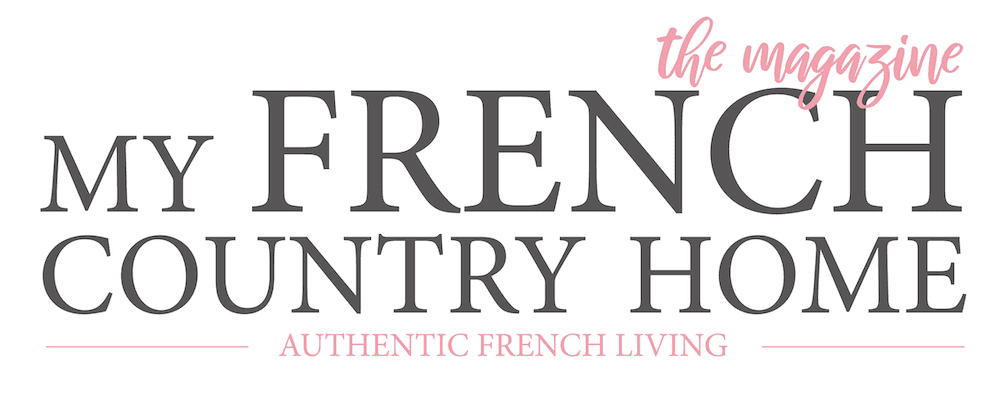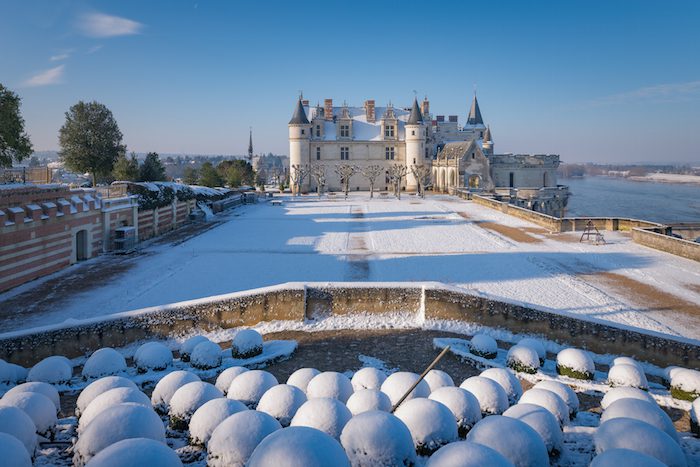While spring offers beautiful flowers and touring domains by bike, there’s a definite charm to visiting the châteaux of the Loire Valley in winter. Naturally, there are fewer people visiting at this time of year, and the châteaux look sublime covered in steel-colored frost or a thick layer of snow.
Every Holiday season in the Touraine Loire Valley is marked by Noel aux Pays de Châteaux. Amboise, Azay-le-Rideau, Chenonceau, Chinon, Langeais, Loches… The Loire’s most famous châteaux get in the Christmas spirit with lavish decoration and festive events. A great way to tour France’s most famous regal residences if you’re over for the Holidays.
Read on for some of our best Loire Valley châteaux to visit in winter. Photographed in deep snow, they will surely get you in the mood for your next trip!
SUBSCRIBE TO THE MAGAZINE
…………………
Our Favorite Loire Châteaux to Visit in Winter
Château d’Amboise
A historic monument since 1840, Château d’Amboise has been a favorite with French royals since its construction. And it has lost no favor with contemporary visitors either! Amboise is a fine example of the early French Renaissance style, largely thanks to King Charles VIII who introduced architectural elements that he discovered while traveling in Italy.
King François the First grew up here, and later on in life invited Leonardo da Vinci to be his painter/engineer in residence. Amboise became da Vinci’s final resting place and you can visit the artist’s tomb.
With its enormous terrace with panoramic views over the Loire river and surrounding valley, you can understand why French kings and queens were enchanted by Amboise.
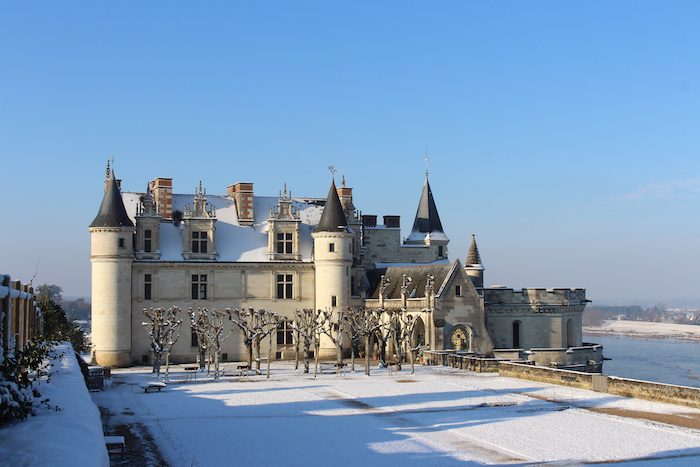
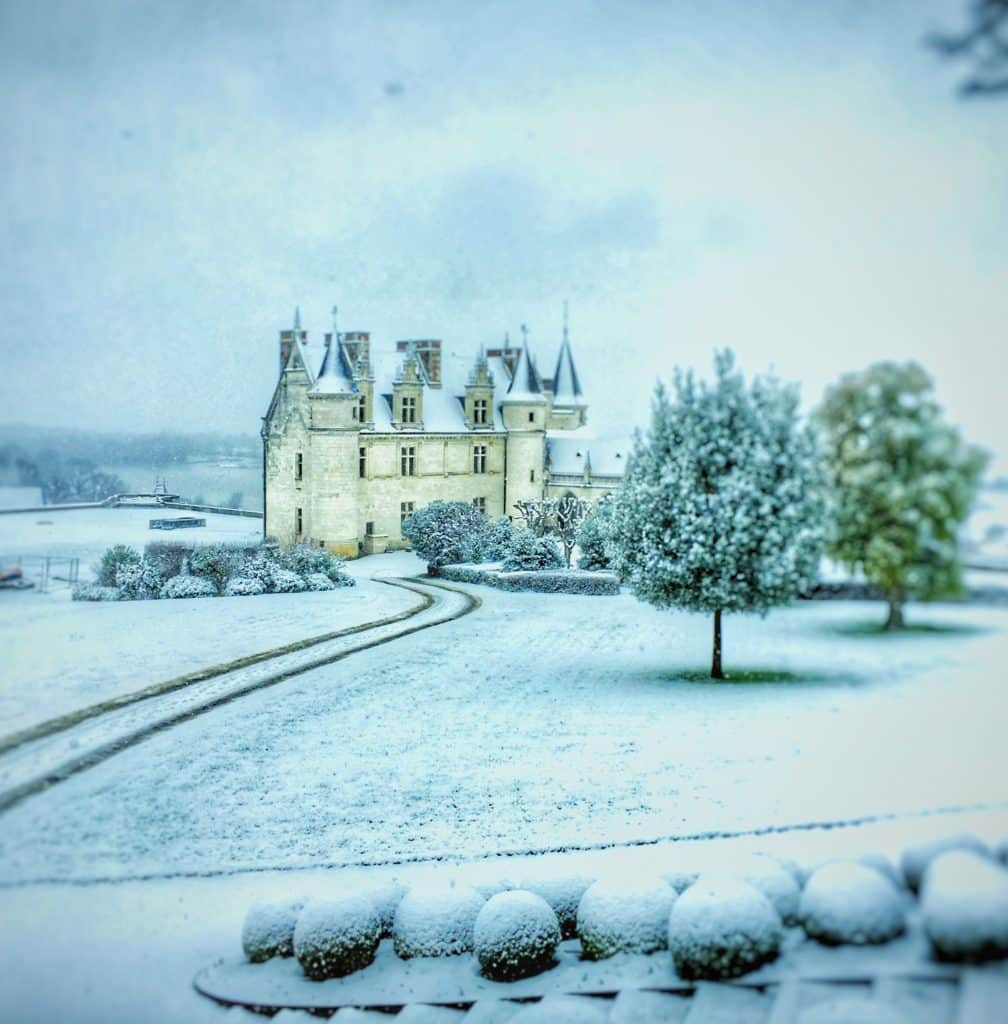
Château d’Amboise and gardens
Montée de l’Emir Abd el Kader, 37400 Amboise
www.chateau-amboise.com
Château de Chenonceau
With its arches cresting over the river Cher, Chenonceau is quite a sight to behold. Its unique architecture, site and style make it the most visited château in France, after Versailles.
The history of Chenonceau is particularly special in that it was developed in three different stages by three women who inhabited it over the years. Diane de Poitiers, mistress to Henry II; Henry’s wife/widow Catherine de’ Medici; and Catherine’s daughter-in-law, Louise de Lorraine.
The rivalry between Diane and Catherine is palpable throughout the domain, especially in the garden. Each woman has their own, sat on opposite sides of the chateau. The Diane de Poitiers Garden is a fine example of a floating parterre and beautiful symmetrical design. Visit the Loire Valley in winter and you’ll be treated to the château’s now-famous bouquets, dressed in their festive finest.
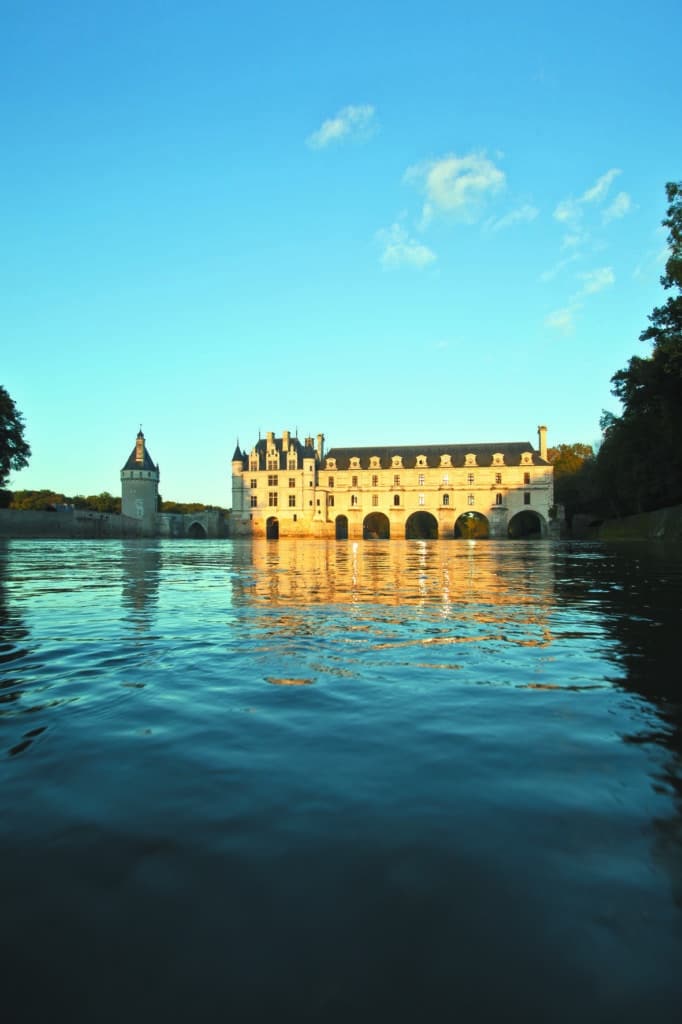
Château de Chenonceau
37150 Chenonceaux
www.chenonceau.com
Royal Fortress of Chinon
The Forteresse Royale de Chinon stands as an important part of French history. It was the favored residence of Henry II, who can be credited for the majority of the building we see today.
Chinon was also were religious missionary Joan of Arc came to meet Charles VII before the crucial siege of Orléans. Two rooms are dedicated to Joan in the newly-renovated interior, with an exhibition of original artifacts from the 18th to 20th centuries.
Sat high on the banks of the Vienne river, Chinon is the epitome of a castle stronghold. Its gardens and rocky outcrops make for an intrepid winter walk.
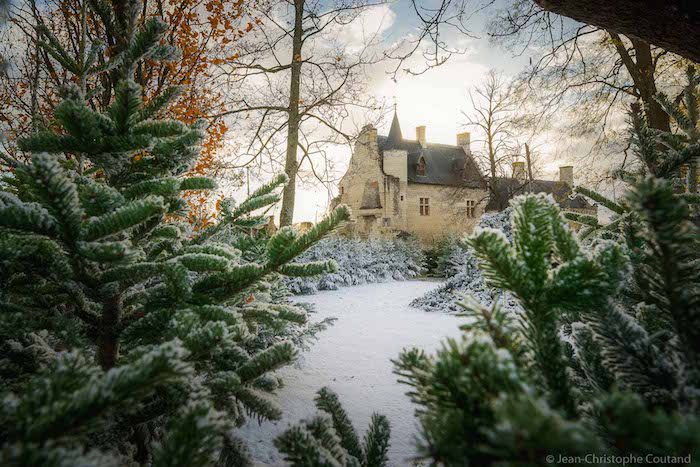
Château de Chinon
37500 Chinon
www.forteressechinon.fr
Château de Chambord
With half a millennia of history between its walls, Chambord is an architectural feat and an important symbol of French power. François the First ordered its construction, but despite its impressive stature he never officially stayed here. Keeping the Chambord (with its adjoining forest) as his hunting lodge, he maintained Château de Blois and Amboise as his official royal residences. While the original design is linked to Italian architect Domenico da Cortona; elements, including the famous double helix staircase, were inspired by Leonardo da Vinci.
In 2017, the Président himself approved a large-scale project to renovate the formal French gardens. The works, which took seven months to complete, now seamlessly tie the château’s façade with the forest beyond. The forest is a treat in itself. There are 13 500 acres of natural parkland filled with deer, wild boar, and various bird species, ready to be explored.
Chambord celebrated its 500th birthday in 2019. All the more reason to go visit the Loire Valley this winter!
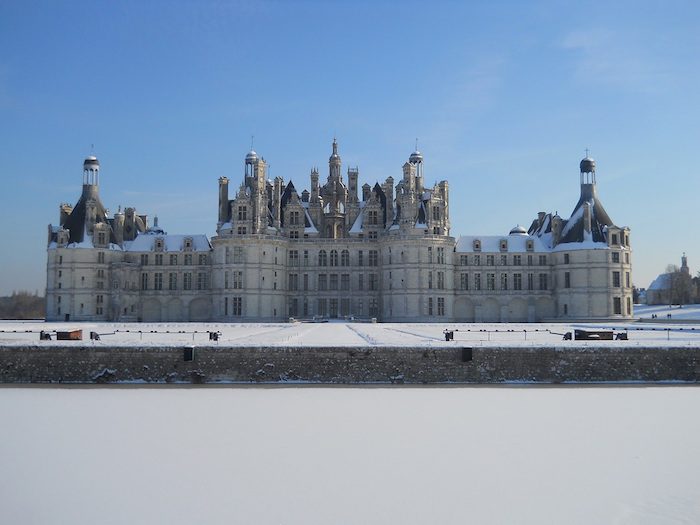
Château de Chambord
Château, 41250 Chambord
www.chambord.org
Château-de-Langeais
Fought over between Count of Anjou, Foulques Nerra, and the Count of Blois, Eudes I, Château-de-Langeais spent a large part of its early life in war. It was kept within the House of Anjou for many years, up until the Hundred Years’ War, were armies took over the fortress.
Charles VII bought it in 1422, ordering that it be destroyed, except for the keep. Saved from ruin, is one of the oldest stone keeps still standing today. In 1465, King Louis XI spent two years renovating the Langeais structure, modernizing it. Although no longer a fortified castle, its large towers, drawbridge and parapet will check all the boxes for fans of the Middle Ages.
Inside, there is 15 rooms and an impressive 16th and 18th centuries tapestry collection to explore. An ideal French château to visit in wintertime.
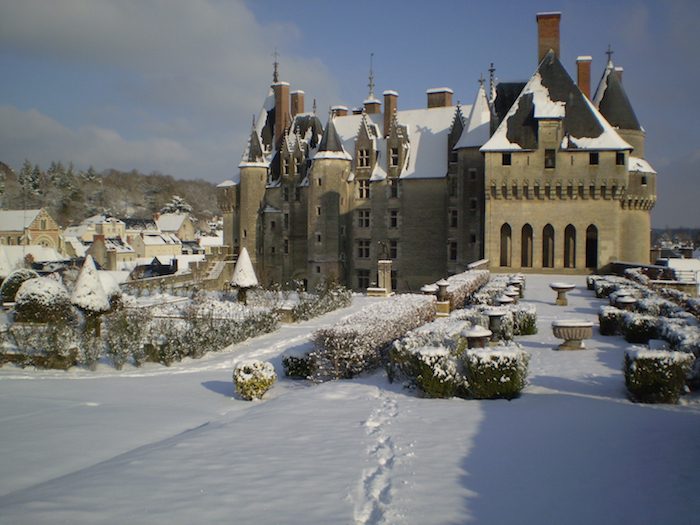
Château-de-Langeais
Place Pierre de Brosse, 37130 Langeais
www.chateau-de-langeais.com
Château d’Azay-le-Rideau
Commissioned by King François the First, Azay-le-Rideau was built on an island in the river Indre. This special position gives it a ‘water mirror’ effect, where the small but statuesque building is perfectly reflected in the glass-like river below.
Author Honoré de Balzac described it as “a faceted diamond set in the Indre”. Its French Renaissance architecture, trimmed gardens and blend of French and Italian decor make it one of the jewels in the Loire’s crown.
The château was built in 1731 by nobleman Charles de Biencourt, a botany enthusiast who set about landscaping the parks into an English style garden. His son who inherited the castle continued to tend to the gardens by planting then-exotic trees like Sequoia, Cedar, American tulip, making Azay-le-Rideau a picturesque château to visit in winter and throughout the year, too.
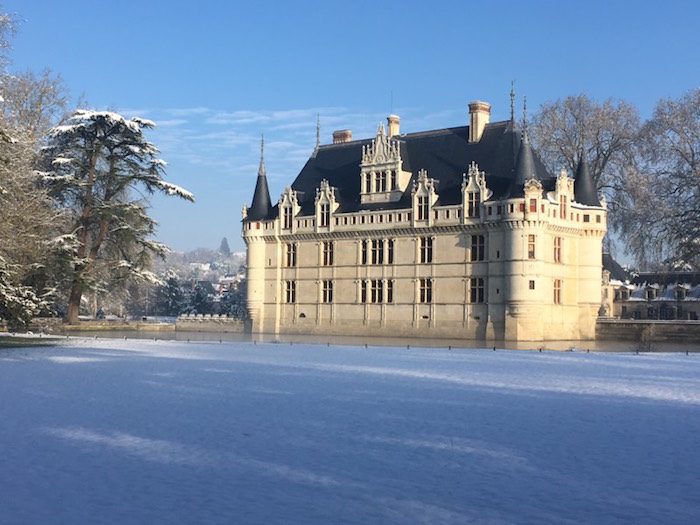
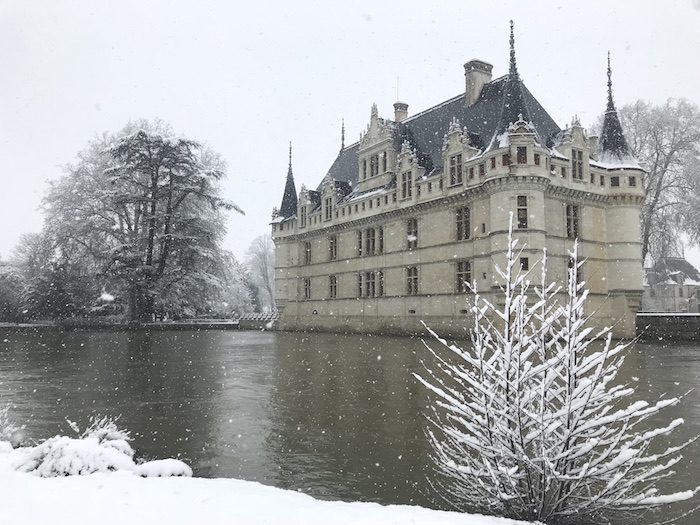
Château d’Azay-le-Rideau
Rue de Pineau, 37190 Azay-le-Rideau
www.azay-le-rideau.fr
SUBSCRIBE TO MY
subscribe to the magazine
Photos © Department of Touraine Loire
